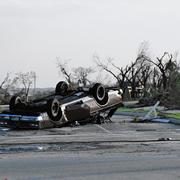 High winds are headed for Texas this weekend.© Punchstock
High winds are headed for Texas this weekend.© PunchstockLate last month, a Houston medical school finally got a US$50-million insurance payout for damages it sustained during a tropical storm four years ago.
The money, ironically, comes just in time for the Texas Medical Center to face up to another storm: Hurricane Rita is due to strike this weekend.
At least this time they'll be better prepared, say lab officials, recalling lessons they learned in 2001 from the tropical storm nicknamed Allison. That storm flooded the multi-institutional centre, drowning research animals in basement labs and causing priceless tissue and cell samples to thaw and be destroyed. All told, Allison wreaked $2 billion in losses. The affected institutions are only just starting to recover this money.
Since that disaster, the medical centre has spent millions of dollars to prevent future storm damage. Flood gates have been installed and auxiliary power generators moved to higher floors. The measures may well come into play during the evening of Friday 23 September and the following morning, when Rita is expected to slam into the Texas coast.
Evacuation
By Friday morning, most of the low-lying parts of Houston had been evacuated. Traffic jams snarled the interstates leading north from the city, away from the oncoming storm.
At the Baylor College of Medicine, part of the Texas Medical Center, researchers and students had cleared out. Susan Berget, vice-president of academic planning, was one of several officials who planned to hunker down on the campus to ride out the storm and assess the damage afterwards.
Following the 2001 storm, Berget learned firsthand how ill-prepared the US Federal Emergency Management Agency (FEMA) was for research emergencies. "They had never thought of how to deal with a research loss," she says. "To them, transgenic mice is a foreign concept."
Houston scientists have long talked of the consequences of tropical storms, but before Allison they had taken little action. When oncologist Kent Osborne moved from San Antonio to Baylor in 1999, taking with him the world's largest bank of breast-cancer tumour specimens, he was concerned about flooding. The collection contained about 100,000 specimens and was later valued between $100 million and $300 million.
When Baylor proposed putting the bank's 30 massive freezers in the flood-vulnerable basement, "we put up a fight," says Osborne. But the freezers weighed so much they couldn't go on higher floors. They stayed down below until Allison's flood waters "tossed them around like toys", he says.
Pay back
Research losses are usually only partly covered by insurance. After a natural disaster, FEMA pays 75% of certain losses; under such terms, it contributed $4.5 million for Baylor to buy 2,000 breast-cancer specimens to help rebuild its bank.
Allison prompted other Houston universities to make major changes. "We have nothing that can be destroyed by water on our lower floors," says Stanley Schultz, dean of the medical school at the University of Texas. Their preparations will undoubtedly be tested this weekend by Rita.
In New Orleans, the lessons of Allison apparently failed to sink in. After Hurricane Katrina flooded the city on 30 August, the medical centres at Louisiana State and Tulane universities lost their auxiliary generators. The backup power supplies had been located on the ground floors and were easily knocked out by flooding; countless research samples were lost.
"Allison was a wakeup call," says Tyler Curiel, an oncologist at Tulane University Medical Center in New Orleans.
